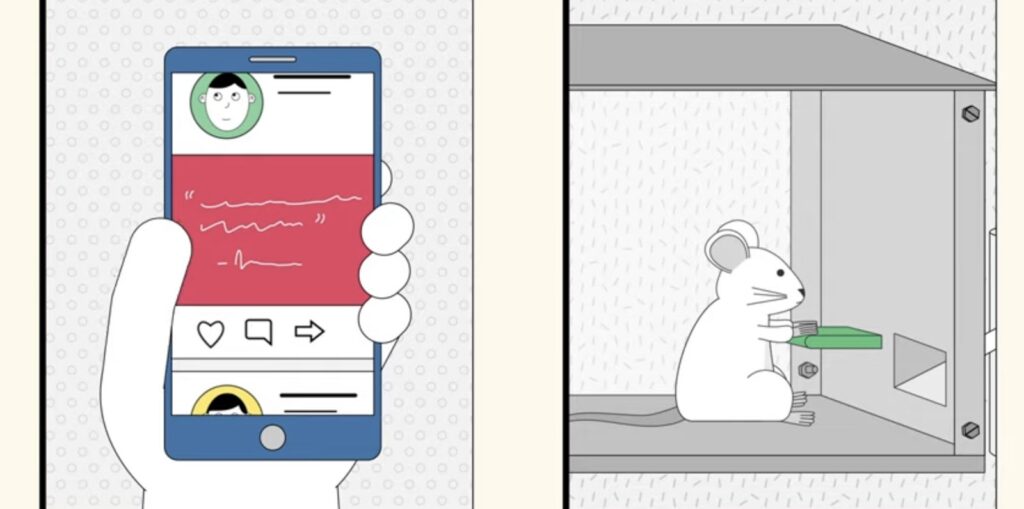Scrolling, an integral component of digital navigation, particularly on touchscreen devices, has revolutionized how content is consumed online. It enables a singular “page” to hold an almost infinite amount of information, facilitating continuous content delivery. However, while effective scrolling can significantly enhance user experience, poor implementation can lead to a range of issues, with scrolling fatigue being a prominent concern.
What Is Scrolling Fatigue?
Scrolling fatigue occurs when users become overwhelmed or frustrated while navigating through a website or app. This can result in a diminished focus or complete disengagement. There are two primary types of scrolling fatigue: zombie scrolling, where users continue to scroll without engaging with the content, and rage quitting, which involves users exiting the site in frustration.
Impact of Reading Habits on User Experience
Reading habits have evolved significantly over thousands of years, adapting to the mediums used. In the digital realm, users tend to scan content rather than read every word. Designers can facilitate this by using descriptive headings and highlighting key sections.
Negative space is crucial in digital design as it allows users to focus on one element at a time, enhancing content digestion. Breaks in the text are equally important, as they provide relief from continuous reading, reducing the likelihood of fatigue.
Digital Adaptation and Historical Context
In the past, publishing constraints led to densely packed information on a single page. Over time, norms around layout and formatting developed, often resulting in crowded pages. In contrast, the digital era allows for more spacious layouts. Today’s standards focus on user-centric designs, considering the physical and psychological effects of constant digital engagement.
This shift reflects a broader understanding of how design impacts user experience, with younger generations being particularly attuned to the physical demands of constant digital interaction.
Causes of Scrolling Fatigue
Scrolling fatigue arises not from the act of scrolling itself but from poor design choices. Several factors contribute to this issue:
- Lack of Focus Points: Text without sufficient focus points can be challenging to navigate. Effective use of headings, bullet points, and bold text helps guide the user’s eye and maintain engagement. Overuse of these elements, however, can lead to distraction;
- Overly Long or Disorganized Content: Users generally prefer concise, well-structured content. Long-winded, disorganized, or whimsical writing can be off-putting. Keeping content succinct and relevant is key to maintaining user interest;
- Quality of Writing: High-quality writing is essential for a positive user experience. Poorly written content, full of errors or awkward phrasing, not only hampers understanding but also reflects poorly on the brand’s professionalism;
- Design Elements: The overall design, including color choices, font styles, and imagery, plays a crucial role in how users perceive and interact with content. Designs that are difficult to read or visually overwhelming can contribute to scrolling fatigue.
Designing for Optimal User Experience
To combat scrolling fatigue, designers must consider various elements that contribute to a seamless user experience:
- User-Centric Design: Websites and apps should be designed with the user’s needs and preferences in mind. This involves understanding the target audience’s behavior, preferences, and limitations;
- Content Hierarchy: Organizing content with a clear hierarchy helps users find information quickly and efficiently. A logical flow of information, with critical points highlighted, enhances user engagement;
- Interactive Elements: Incorporating interactive elements such as clickable buttons, expandable sections, and multimedia content can break the monotony of scrolling, offering a more dynamic experience;
- Responsive Design: With the variety of devices used to access digital content, responsive design is crucial. Ensuring that content is easily navigable and visually appealing across different screen sizes and devices is key to preventing scrolling fatigue;
- Accessibility: Designing for accessibility ensures that content is usable by people with a wide range of abilities. This includes considering color contrasts, font sizes, and alternative text for images;
- Load Time and Performance: Websites and apps that load quickly and perform smoothly contribute to a positive user experience. Slow load times and lag can frustrate users, leading to disengagement;
- Regular Testing and Feedback: Continuously testing and seeking feedback on the design and content can help identify areas that may contribute to scrolling fatigue. This iterative process allows for ongoing improvement and adaptation;
- Personalization: Offering personalized content based on user preferences and behavior can make the scrolling experience more relevant and engaging, reducing the likelihood of fatigue.
Future Trends in Digital Design
As technology continues to evolve, so too will the approaches to combating scrolling fatigue. Emerging trends in digital design, such as the use of artificial intelligence and machine learning, offer new ways to personalize user experiences and predict user needs.
Advancements in virtual and augmented reality could also redefine how content is presented and navigated, potentially offering alternatives to traditional scrolling interfaces. Scrolling fatigue is a significant concern in the digital world, influenced by a variety of factors related to content presentation, organization, and overall design. Addressing these factors effectively requires a comprehensive approach that considers the user’s entire experience, from the initial engagement to the final interaction. By prioritizing user-centric design, ensuring content quality, and embracing technological advancements, designers can create digital experiences that are engaging, enjoyable, and free from the pitfalls of scrolling fatigue.
Scrolling fatigue, a common experience in the digital realm, affects users in two main forms: zombie scrolling and rage quitting. Both are detrimental to user engagement and can significantly impact a business.
Zombie-Scrolling: Mindless Browsing
Zombie-scrolling occurs when users engage in aimless, mechanical scrolling, often losing track of time without absorbing much content. It’s akin to mindlessly flipping through a magazine without paying attention to the articles. This behavior can start unintentionally, like checking a phone out of habit, or it can evolve from an initial focused reading that gradually loses purpose.
Rage-Quitting: Frustration-Induced Exit
Rage-quitting is a user’s response to extreme frustration with a digital interface. Causes include slow load times, complex navigation, poorly placed buttons, or an overwhelming amount of content. Users facing such issues may abruptly abandon their activity in exasperation, often not returning.
The Persistence and Necessity of Scrolling
Despite its associated fatigue, scrolling is a fundamental aspect of digital navigation. Its continued popularity is attributed to several factors:
- Convenience on Small Screens: On devices like smartphones, scrolling provides a more fluid experience than navigating through multiple pages;
- Suitability for Long-Form Content: Scrolling is less disruptive than page-turning, especially for extended reads;
- User Familiarity and Preference: Most users are comfortable with scrolling and often prefer it over other navigation methods;
- Enhanced Memory Retention: Studies suggest that scrolling can improve information retention compared to flipping through pages.
Scrolling’s Role in User Experience
Scrolling directly influences the user interface (UI) and user experience (UX). Since UX can be a deciding factor in a product’s success, minimizing scrolling fatigue is essential. Users generally seek a balance between easy access to information and an uncluttered, navigable interface.
Strategies to Mitigate Scrolling Fatigue
There are several approaches to reduce scrolling fatigue among users:
- Creative Focus Points: Strategic placement of interesting elements can maintain user engagement during scrolling;
- Scroll-Based Rewards: Incorporating non-distracting rewards like animations or sounds for scrolling can enhance the user experience;
- Minimalist Design: Simplified layouts with clear navigation paths help users focus on the content without feeling overwhelmed.
Content Creation to Counteract Fatigue
Effective content strategy is crucial in combating scrolling fatigue:
- Captivating Introduction: Engaging users from the outset is critical for maintaining interest;
- Maintaining Relevance: Content should remain on-topic and avoid unnecessary tangents;
- Emphasizing Clarity: Using straightforward language enhances user understanding and engagement;
- Intelligent Use of Visuals: Images and graphics, when used appropriately, can break the monotony of text-heavy content.
Designing Against Fatigue
Designers play a significant role in preventing scrolling fatigue:
- Unexpected Visual Elements: Surprising yet pleasing visual changes can keep users interested;
- Clarity on Content Length: Users should be aware of additional content below the fold to prevent misconceptions about content length;
- Navigational Cues: Providing clear indicators of where the user is and what lies ahead can greatly enhance the scrolling experience;
- Effective Use of Negative Space: Negative space can provide visual relief, making content more digestible.

Navigational Techniques for Smooth Scrolling
Optimizing navigation is key to a positive scrolling experience:
- Sticky Navigation Menus: These allow for easy access to different sections, reducing unnecessary scrolling;
- Jump-To Links: For long or infinite scrolling pages, providing quick navigation options can improve user orientation;
- Consistent Back Button Functionality: Ensuring that users return to the same place on a page after navigating away enhances usability.
Testing for an Engaging Experience
Regular testing is vital for refining the scrolling experience:
- Usability Studies: These assess how user-friendly and intuitive the scrolling is;
- User Acceptance Tests: These determine whether the product meets users’ needs and expectations;
- Rapid Prototyping Tests: Quick, iterative testing can identify issues early in the design process.
Beyond Scrolling: Enhancing Overall User Interaction
While scrolling is a key focus, other elements of the user experience are equally important. This includes the overall layout, interactive elements, load times, and responsiveness of the site or app.
- Load Times and Performance: Users expect quick and smooth performance. Delays or lags in loading can lead to frustration and contribute to scrolling fatigue;
- Interactive Elements: Well-designed buttons, links, and other interactive components can make the user’s journey more engaging and less tedious;
- Personalization and User Preferences: Tailoring content and navigation based on user preferences can make the experience more relevant and enjoyable, reducing the likelihood of fatigue;
- Accessibility in Design: Ensuring that the site or app is accessible to all users, including those with disabilities, is crucial. This includes considering aspects like color contrast, text size, and alternative text for images.
Emerging Technologies and Scrolling Alternatives
As technology advances, new methods of presenting and navigating content are emerging. This includes voice-activated interfaces, gesture-based navigation, and even virtual and augmented reality environments, offering alternatives to traditional scrolling.
The Future of Digital Navigation
The future of digital navigation may see a shift away from traditional scrolling towards more innovative and user-friendly methods. This evolution will be driven by advancements in technology, changes in user behavior, and a continuous focus on improving the overall user experience.
Conclusion
In summary, while scrolling is an integral and enduring element of digital navigation, it’s crucial to address the associated fatigue. By understanding user behaviors, employing effective design and content strategies, and embracing technological advancements, designers and developers can create digital experiences that are engaging, comfortable, and free from the pitfalls of scrolling fatigue. This holistic approach to design and user experience is key to developing successful digital products that resonate with users and stand the test of time.
